Allelopathic Activity of Leaf Wastes of Liriodendron tulipifera for Sustainable Management
Abstract
1. Introduction
2. Materials and Methods
2.1. Plant Materials
2.2. Determination of the Allelopathic Activity of L. tulipifera Fresh and Fallen Leaves under Laboratory Conditions
2.3. Allelopathic Activity of L. tulipifera Fresh and Fallen Leaves under Greenhouse Conditions
2.4. Isolation of an Allelochemical from L. tulipifera Fresh and Fallen Leaves
2.5. Allelopathic Activity of the Isolated Compound
2.6. Statistical Analysis
3. Results
3.1. Allelopathic Activity of L. tulipifera Fresh and Fallen Leaves under Laboratory Conditions
3.2. Allelopathic Activity of L. tulipifera Fresh and Fallen Leaves under Greenhouse Conditions
3.3. Isolation and Identification of Allelochemicals in L. tulipifera Fresh and Fallen Leaves
3.4. Allelopathic Activity of the Isolated Compound
4. Discussion
4.1. Allelopathic Activity of the Fresh and Fallen Leaves of L. tulipifera
4.2. An Allelochemical in L. tulipifera Leaves
5. Conclusions
Supplementary Materials
Author Contributions
Funding
Institutional Review Board Statement
Data Availability Statement
Conflicts of Interest
References
- Plant Database. Liriodendron tulipifera. Available online: https://www.wildflower.org/plants/result.php?id_plant=LITU (accessed on 8 July 2024).
- US Forest Service. Liriodendron tulipifera. Available online: https://www.fs.usda.gov/database/feis/plants/tree/lirtul/all.html (accessed on 8 July 2024).
- Ryu, K.O.; Jang, S.S.; Choi, W.Y.; Kim, H.E. Growth performance and adaptation of Liriodendron tulipifera in Korea. J. Korean For. Soc. 2003, 92, 515–525. [Google Scholar]
- Bozsik, A. Spread and occurrence of tulip tree aphid in Europe: New record of Illinoia liriodendri (Monell, 1879) (Hemiptera: Aphididae) from Hungary. EPPO Bull. 2012, 42, 154–157. [Google Scholar] [CrossRef]
- Cao, Y.; Feng, J.; Hwarari, D.; Ahmad, B.; Wu, H.; Chen, J.; Yang, L. Alterations in population distribution of Liriodendron chinense (Hemsl.) Sarg. and Liriodendron tulipifera Linn. caused by climate change. Forests 2022, 13, 488. [Google Scholar] [CrossRef]
- Gilman, E.F.; Watson, D.G. Liriodendron tulipifera: Tuliptree. UF-IFAS 1993, 363, 1–4. [Google Scholar]
- Spongberg, S.A.; Bell, A.C. Liriodendron tulipifera: The tulip tree. New Plantsman 1996, 3, 204–215. [Google Scholar]
- USDA, Forest Service. Yellow-Poplar (Liriodendron tulipifera). Available online: https://www.fs.usda.gov/nrs/atlas/tree/v3/621 (accessed on 8 July 2024).
- The Wood Database (Hardwood). Yellow Poplar. Available online: https://www.wood-database.com/yellow-poplar/ (accessed on 8 July 2024).
- Hernandez, R.; Davalos, J.F.; Sonti, S.S.; Kim, Y.; Moody, R.C. Strength and Stiffness of Reinforced Yellow-Poplar Glued Laminated Beams; US Department of Agriculture, Forest Service, Forest Products Laboratory: Washington, DC, USA, 1997; Volume 554, pp. 1–23. [Google Scholar]
- Williams, R.S.; Feist, W.C. Durability of yellow-poplar and sweetgum and service life of finishes after long-term exposure. For. Prod. J. 2004, 54, 96–101. [Google Scholar]
- Kim, M.J.; Lee, S.J.; Kim, S.; Yang, M.S.; Son, D.W.; Kim, C.K. Study on the combustion characteristics of tulip tree (Liriodendron tulipifera) for use as interior building materials. J. Korean Wood Sci. Technol. 2023, 51, 410–418. [Google Scholar] [CrossRef]
- Dionco-Adetayo, E.A. Utilization of wood wastes in Nigeria: A feasibility overview. Technovation 2001, 21, 55–60. [Google Scholar] [CrossRef]
- Eshun, J.F.; Potting, J.; Leemans, R. Wood waste minimization in the timber sector of Ghana: A systems approach to reduce environmental impact. J. Clean. Prod. 2012, 26, 67–78. [Google Scholar] [CrossRef]
- Adhikari, S.; Ozarska, B. Minimizing environmental impacts of timber products through the production process “From Sawmill to Final Products”. Environ. Syst. Res. 2018, 7, 6. [Google Scholar] [CrossRef]
- Kim, K.H.; Eom, I.Y.; Lee, S.M.; Choi, D.; Yeo, H.; Choi, I.G.; Choi, J.W. Investigation of physicochemical properties of biooils produced from yellow poplar wood (Liriodendron tulipifera) at various temperatures and residence times. J. Anal. Appl. Pyrolysis 2011, 92, 2–9. [Google Scholar] [CrossRef]
- Ahn, B.J.; Chang, H.S.; Lee, S.M.; Choi, D.H.; Cho, S.T.; Han, G.S.; Yang, I. Effect of binders on the durability of wood pellets fabricated from Larix kaemferi C. and Liriodendron tulipifera L. sawdust. Renew. Energy 2014, 62, 18–23. [Google Scholar] [CrossRef]
- Jung, J.Y.; Choi, M.S.; Kim, J.S.; Jeong, M.J.; Kim, Y.W.; Woon, B.T.; Yeo, J.K.; Shin, H.N.; Goo, Y.B.; Ryu, K.O.; et al. Enzymatic hydrolysate from non-pretreated biomass of yellow poplar (Liriodendron tulipifera) is an alternative resource for bioethanol production. J. Korean Soc. For. Sci. 2010, 99, 744–749. [Google Scholar]
- Kim, H.Y.; Gwak, K.S.; Lee, S.Y.; Jeong, H.S.; Ryu, K.O.; Choi, I.G. Biomass characteristics and ethanol production of yellow poplar (Liriodendron tulipifera) treated with slurry composting and biofiltration liquid as fertilizer. Biomass Bioenergy 2012, 42, 10–17. [Google Scholar] [CrossRef]
- Boldrin, A.; Christensen, T.H. Seasonal generation and composition of garden waste in Aarhus (Denmark). Waste Manag. 2010, 30, 551–557. [Google Scholar] [CrossRef] [PubMed]
- Rafinesque, C.S. Medical Flora; Or, Manual of the Medical Botany of the United States of North America; Atkinson & Alexander: Philadelphia, PA, USA, 1828; pp. 1–376. [Google Scholar]
- Thacher, J. American Medical Biography; Or, Memoirs of Eminent Physicians Who Have Flourished in America, to Which is Prefixed a Succinct History of Medical Science in the United States from the First Settlement of the Country; Milford House: New York, NY, USA, 1967; pp. 1–799. [Google Scholar]
- Graziose, R.; Rathinasabapathy, T.; Lategan, C.; Poulev, A.; Smith, P.J.; Grace, M.; Lia, M.A.; Raskin, I. Antiplasmodial activity of aporphine alkaloids and sesquiterpene lactones from Liriodendron tulipifera L. J. Ethnopharmacol. 2011, 133, 26–30. [Google Scholar] [CrossRef]
- Kang, Y.F.; Liu, C.M.; Kao, C.L.; Chen, C.Y. Antioxidant and anticancer constituents from the leaves of Liriodendron tulipifera. Molecules 2014, 19, 4234–4245. [Google Scholar] [CrossRef]
- Chen, L.C.; Chang, H.M. Lignans and aporphine alkaloids in bark of Liriodendron tulipifera. Phytochemistry 1978, 17, 779–782. [Google Scholar] [CrossRef]
- Hufford, C.D.; Funderburk, M.J.; Morgan, J.M.; Robertson, L.W. Two antimicrobial alkaloids from heartwood of Liriodendron tulipifera L. J. Pharm. Sci. 1975, 64, 789–792. [Google Scholar] [CrossRef]
- Muhammad, I.; Hufford, C.D. Phenylpropanoids, sesquiterpenes, and alkaloids from the seeds of Liriodendron tulipifera. J. Nat. Prod. 1989, 52, 1177–1179. [Google Scholar] [CrossRef]
- Lee, C.H.; Chen, H.L.; Hong, Z.L.; Hsieh, C.W.; Juan, S.W.; Huang, J.C.; Wang, H.M.; Chen, C.Y. Chemical constituents of Liriodendron tulipifera. Chem. Nat. Compd. 2013, 49, 398–400. [Google Scholar] [CrossRef]
- Mikašauskaitė, J.; Ragažinskienė, O.; Maruška, A. Variation of total amount of phenolic compounds, radical scavenging activity and volatile compounds of Liriodendron tulipifera L. and Ginkgo biloba L. leaves extracts during different vegetation periods. Biologija 2013, 59, 175–186. [Google Scholar] [CrossRef]
- Yadav, A.K.; Kim, S.H.; Kang, S.C. Chemical composition, antioxidant potential and cyto-protecting activity of essential oil of Liriodendron tulipifera L. leaves. Korea J. Herbol. 2015, 30, 1–9. [Google Scholar] [CrossRef]
- Quassinti, L.; Maggi, F.; Ortolani, F.; Lupidi, G.; Petrelli, D.; Vitali, L.A.; Miano, A.; Bramucci, M. Exploring new applications of tulip tree (Liriodendron tulipifera L.): Leaf essential oil as apoptotic agent for human glioblastoma. Environ. Sci. Pollut. Res. 2019, 26, 30485–30497. [Google Scholar] [CrossRef]
- Rice, E.L. Allelopathy, 2nd ed.; Academic Press: Orlando, FL, USA, 1984; pp. 1–422. [Google Scholar]
- Bais, H.P.; Weir, T.L.; Perry, L.G.; Gilroy, S.; Vivanco, J.M. The role of root exudates in rhizosphere interactions with plants and other organisms. Annu. Rev. Plant Biol. 2006, 57, 233–266. [Google Scholar] [CrossRef]
- Bonanomi, G.; Sicurezza, M.G.; Caporaso, S.; Esposito, A.; Mazzoleni, S. Phytotoxicity dynamics of decaying plant materials. New Phytol. 2006, 169, 571–578. [Google Scholar] [CrossRef]
- Kato-Noguchi, H. Defensive molecules momilactones A and B: Function, biosynthesis, induction and occurrence. Toxins 2023, 15, 241. [Google Scholar] [CrossRef]
- Belz, R.G. Allelopathy in crop/weed interactions—An update. Pest. Manag. Sci. 2007, 63, 308–326. [Google Scholar] [CrossRef]
- Macías, F.A.; Molinillo, J.M.G.; Varela, R.M.; Galindo, J.G.G. Allelopathy—A natural alternative for weed control. Pest Manag. Sci. 2007, 63, 327–348. [Google Scholar] [CrossRef]
- Kato-Noguchi, H.; Kato, M. Allelopathy and allelochemicals of Solidago canadensis L. and S. altissima L. for their naturalization. Plants 2022, 11, 3235. [Google Scholar] [CrossRef]
- Kato-Noguchi, H.; Kato, M. Evolution of the secondary metabolites in invasive plant species Chromolaena odorata for the defense and allelopathic functions. Plants 2023, 12, 521. [Google Scholar] [CrossRef] [PubMed]
- Kato-Noguchi, H.; Kurniadie, D. Allelopathy and allelochemicals of Leucaena leucocephala as an invasive plant species. Plants 2022, 11, 1672. [Google Scholar] [CrossRef] [PubMed]
- Kato-Noguchi, H. Invasive mechanisms of one of the world’s worst alien plant species Mimosa pigra and Its management. Plants 2023, 12, 1960. [Google Scholar] [CrossRef] [PubMed]
- Kato-Noguchi, H. The impact and invasive mechanisms of Pueraria montana var. lobata, one of the world’s worst alien species. Plants 2023, 12, 3066. [Google Scholar]
- Kato-Noguchi, H.; Kurniadie, D. The invasive mechanisms of the noxious alien plant species Bidens pilosa. Plants 2024, 13, 356. [Google Scholar] [CrossRef]
- Narwal, S.S. Allelopathy in weed management. In Allelopathy Update; Basic and Applied Aspects; Narwal, S.S., Ed.; Science Publishers Inc.: Enfield, NH, USA, 1999; Volume 2, pp. 203–254. [Google Scholar]
- Global Biodiversity Information Facility. Vulpia myuros. Available online: https://www.gbif.org/species/5289590 (accessed on 8 July 2024).
- Global Biodiversity Information Facility. Lolium multiflorum. Available online: https://www.gbif.org/species/4129708 (accessed on 8 July 2024).
- Global Biodiversity Information Facility. Echinochloa crus-galli. Available online: https://www.gbif.org/species/2702808 (accessed on 8 July 2024).
- Kato-Noguchi, H.; Mori, K.; Iwasaki, A.; Suenaga, K. Allelopathy and allelochemicals in Chamaecyparis obtusa leaves for the development of sustainable agriculture. Agronomy 2024, 14, 1557. [Google Scholar] [CrossRef]
- Rao, A.N.; Johnson, D.E.; Sivaprasad, B.; Ladha, J.K.; Mortimer, A.M. Weed management in direct-seeded rice. Adv. Agron. 2007, 93, 153–255. [Google Scholar]
- Hirai, N.; Yoshida, R.; Todoroki, Y.; Ohigashi, H. Biosynthesis of abscisic acid by the non-mevalonate pathway in plants, and by the mevalonate pathway in fungi. Biosci. Biotechnol. Biochem. 2000, 64, 1448–1458. [Google Scholar] [CrossRef]
- Kato-Noguchi, H.; Kurniadie, D. Allelopathy of Lantana camara as an invasive plant. Plants 2021, 10, 1028. [Google Scholar] [CrossRef]
- Kato-Noguchi, H. Allelopathy and allelochemicals of Imperata cylindrica as an invasive plant species. Plants 2022, 11, 2551. [Google Scholar] [CrossRef]
- Heděnec, P.; Novotný, D.; Ust’ak, S.; Honzík, R.; Kovářová, M.; Šimáčková, H.; Frouz, J. Allelopathic effect of new introduced biofuel crops on the soil biota: A comparative study. Eur. J. Soil Biol. 2014, 63, 14–20. [Google Scholar] [CrossRef]
- Inderjit, S.; Dakshini, K.M.M. Investigations on some aspects of chemical ecology of cogongrass, Imperata cylindrica (L.) Beauv. J. Chem. Ecol. 1991, 17, 343–352. [Google Scholar] [CrossRef] [PubMed]
- Hui-Qiong, Z.; Ning, W.; Liu-Fa, W.; Ping, H.E. Effects of Lantana camara leaf extract on the activity of superoxide dismutase and accumulation of H2O2 in water hyacinth leaf. J. Plant Physiol. Mol. Biol. 2006, 32, 189–194. [Google Scholar]
- Poonpaiboonpipat, T.; Poolkum, S. Utilization of Bidens pilosa var. radiata (Sch. Bip.) Sherff integrated with water irrigation for paddy weed control and rice yield production. Weed Biol. Manag. 2019, 19, 31–38. [Google Scholar] [CrossRef]
- Duke, S.O.; Dayan, F.E.; Romagni, J.G.; Rimando, A.M. Natural products as sources of herbicide, current status and future trends. Weed Res. 2000, 40, 99–111. [Google Scholar] [CrossRef]
- Kato-Noguchi, H.; Hamada, Y.; Kojima, M.; Kumagai, S.; Iwasaki, A.; Suenaga, K. Allelopathic substances of Osmanthus spp. for developing sustainable agriculture. Plants 2023, 12, 376. [Google Scholar] [CrossRef]
- Doskotch, R.W.; Keely, S.L., Jr.; Hufford, C.D.; El-Feraly, F.S. New sesquiterpene lactones from Liriodendron tulipifera. Phytochemistry 1975, 14, 769–773. [Google Scholar] [CrossRef]
- Barbosa, P.; Gross, P.; Provan, G.J.; Pacheco, D.Y.; Stermitz, F.R. Allelochemicals in foliage of unfavored tree hosts of the gypsy moth, Lymantria dispar L. 1. Alkaloids and other components of Liriodendron tulipifera L. (Magnoliaceae), Acer rubrum L. (Aceraceae), and Cornus florida L. (Cornaceae). J. Chem. Ecol. 1990, 16, 1719–1730. [Google Scholar] [CrossRef]
- Iida, T.; Ito, K. Sesquiterpene lactones from Michelia fuscata. Phytochemistry 1982, 21, 701–703. [Google Scholar] [CrossRef]
- Ding, L.F. Sesquiterpenes constituents from fruits of Michelia yunnanensis. Chin. Tradit. Herb. Drugs 2017, 48, 2608–2613. [Google Scholar]
- Katekunlaphan, T.; Chalermglin, R.; Rukachaisirikul, T.; Chalermglin, P. Sesquiterpene lactones from the leaves of Magnolia sirindhorniae. Biochem. Sstem. Ecol. 2014, 57, 152–154. [Google Scholar] [CrossRef]
- Xiong, J.; Wang, L.J.; Qian, J.; Wang, P.P.; Wang, X.J.; Ma, G.L.; Zeng, H.; Hu, J.F. Structurally diverse sesquiterpenoids from the endangered ornamental plant Michelia shiluensis. J. Nat. Prod. 2018, 81, 2195–2204. [Google Scholar] [CrossRef] [PubMed]
- Mossa, J.S.; El-Feraly, F.S.; Muhammad, I.; Zaw, K.; Mbwambo, Z.H.; Pezzuto, J.M.; Fong, H.H. Sesquiterpene lactones and thymol esters from Vicoa pentanema. J. Nat. Prod. 1997, 60, 550–555. [Google Scholar] [CrossRef]
- Dong, Y.; Liang, D.; Huang, J.; Zhang, P. Sesquiterpenes with quinone reductase-inducing activity from Liriodendron chinense. Nat. Prod. Commun. 2009, 4, 467–468. [Google Scholar] [CrossRef]
- Moon, M.K.; Oh, H.M.; Kwon, B.-M.; Baek, N.-I.; Kim, S.-H.; Kim, J.S.; Kim, D.K. Farnesyl protein transferase and tumor cell growth inhibitory activities of lipiferolide isolated from Liriodendron tulipifera. Arch. Pharm. Res. 2007, 30, 299–302. [Google Scholar] [CrossRef]
- Macías, F.A.; Marín, D.; Oliveros-Bastidas, A.; Simonet, A.M.; Molinillo, J.M. Ecological relevance of the degradation processes of allelochemicals. In Allelopathy; Fujii, Y., Hiradate, Y., Eds.; CRC Press: Boca Raton, FL, USA, 2022; pp. 91–107. [Google Scholar]
- Jilani, G.; Mahmood, S.; Chaudhry, A.N.; Hassan, I.; Akram, M. Allelochemicals: Sources, toxicity and microbial transformation in soil—A review. Ann. Microbiol. 2008, 58, 351–357. [Google Scholar] [CrossRef]
- Kato-Noguchi, H.; Kimura, F.; Ohno, O.; Suenaga, K. Involvement of allelopathy in inhibition of understory growth in red pine forests. J. Plant Physiol. 2017, 218, 66–73. [Google Scholar] [CrossRef]
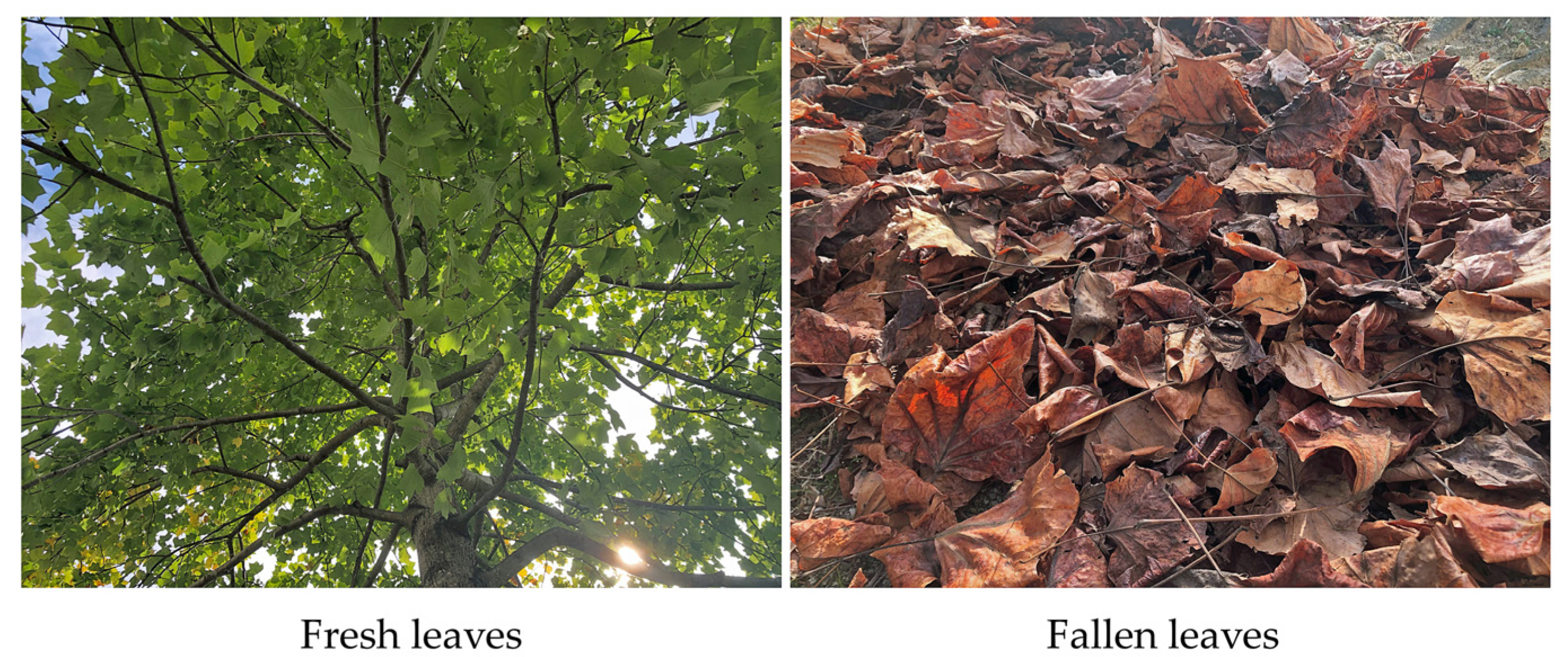
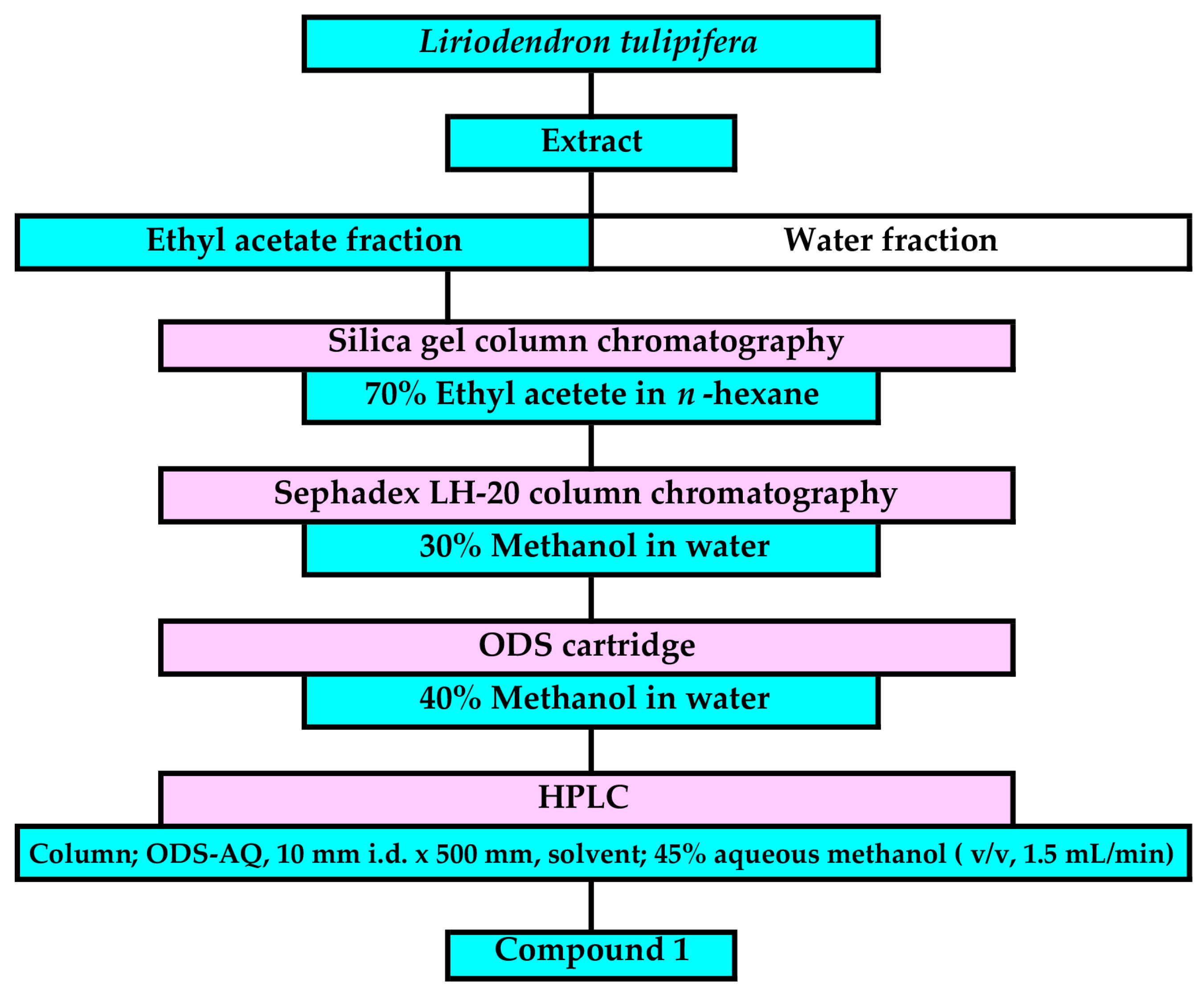
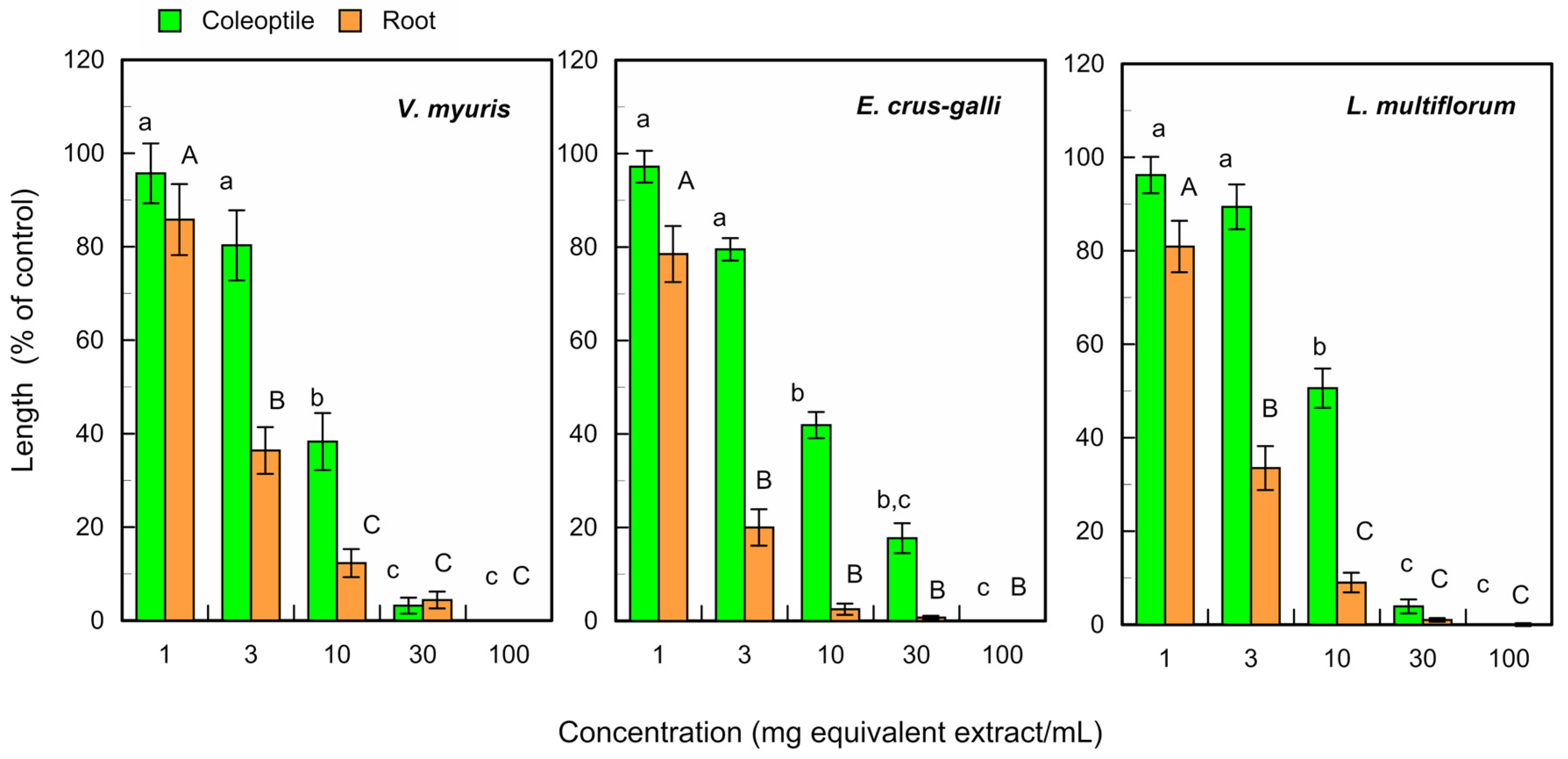
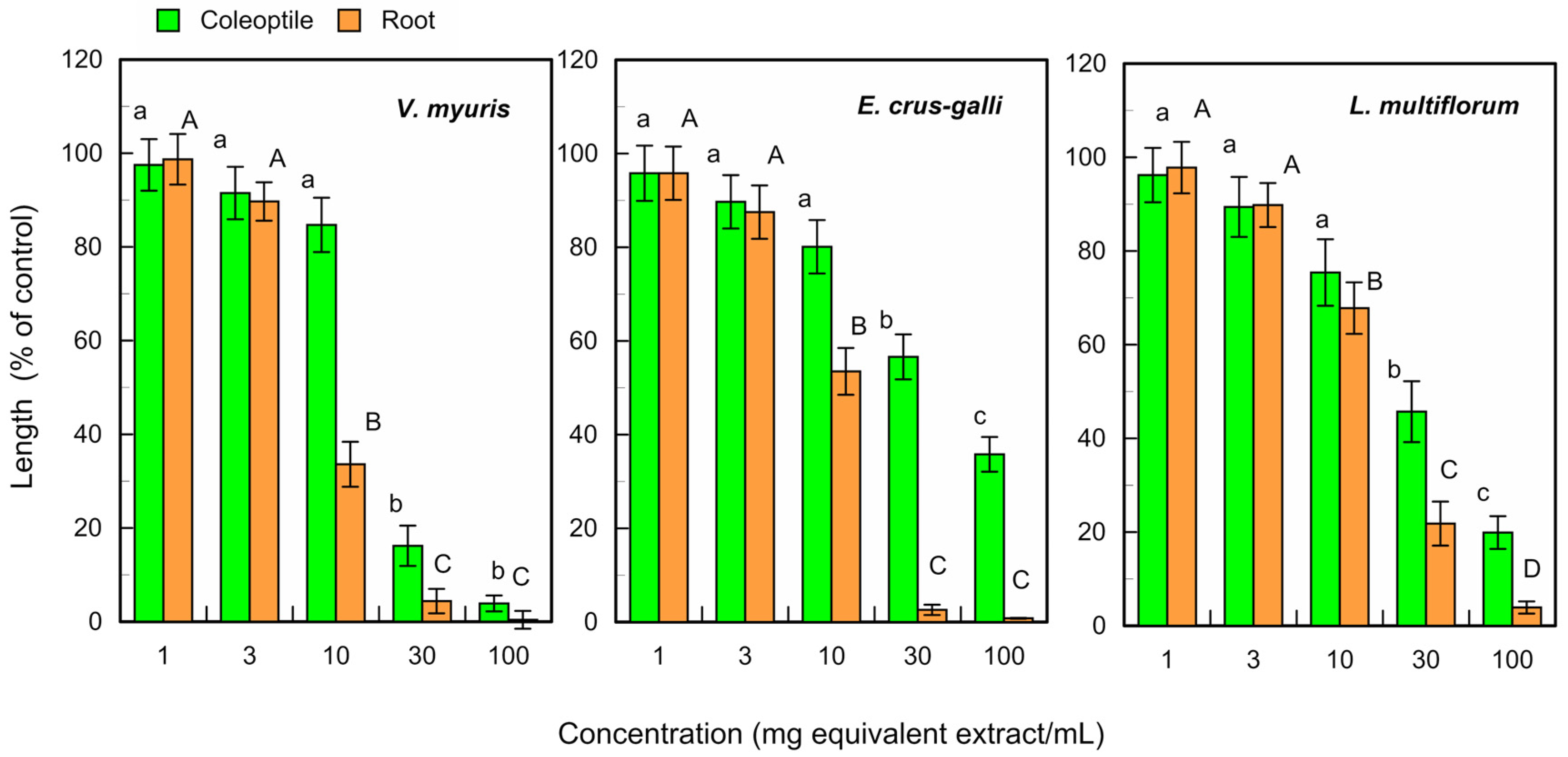
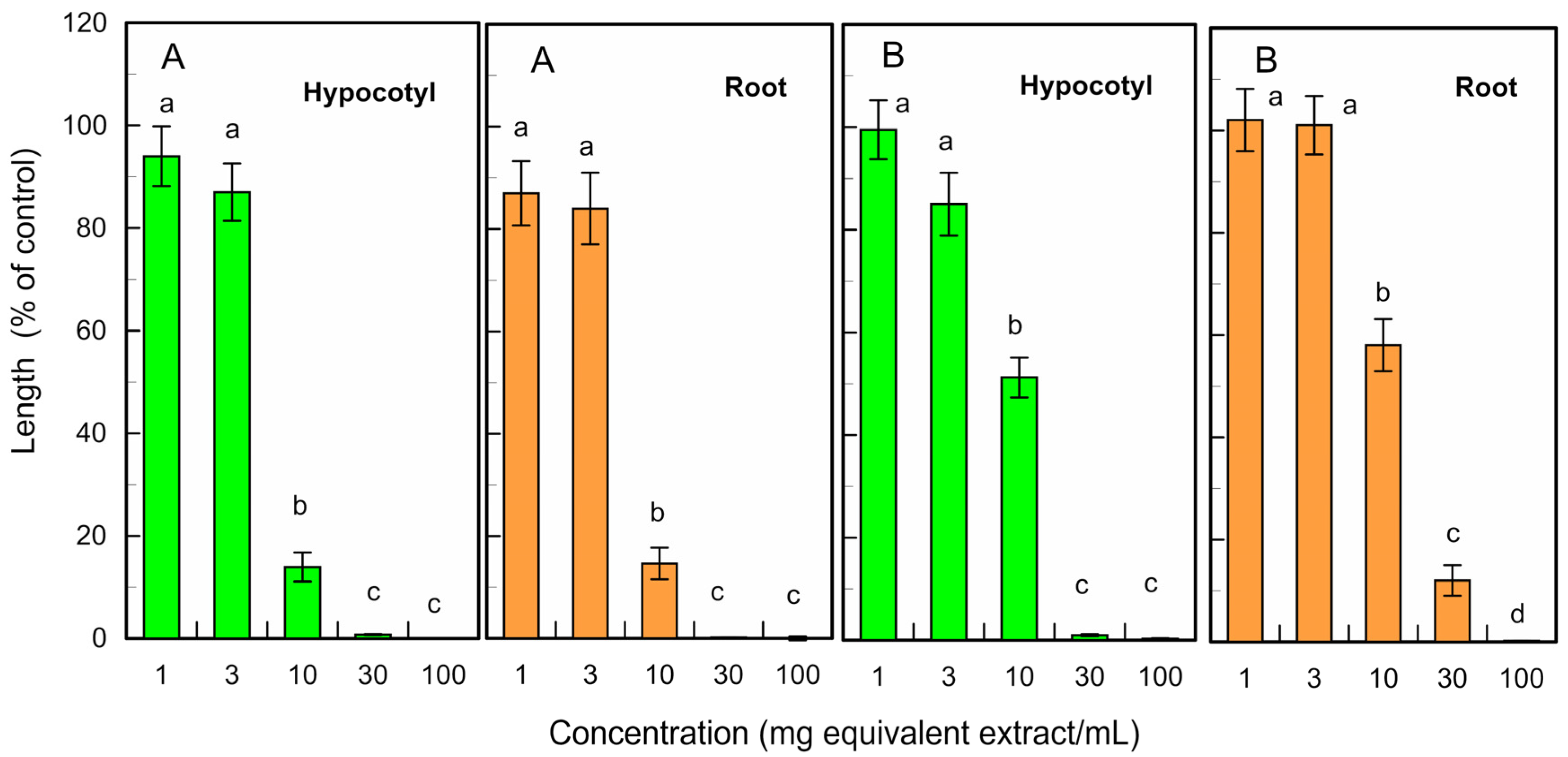
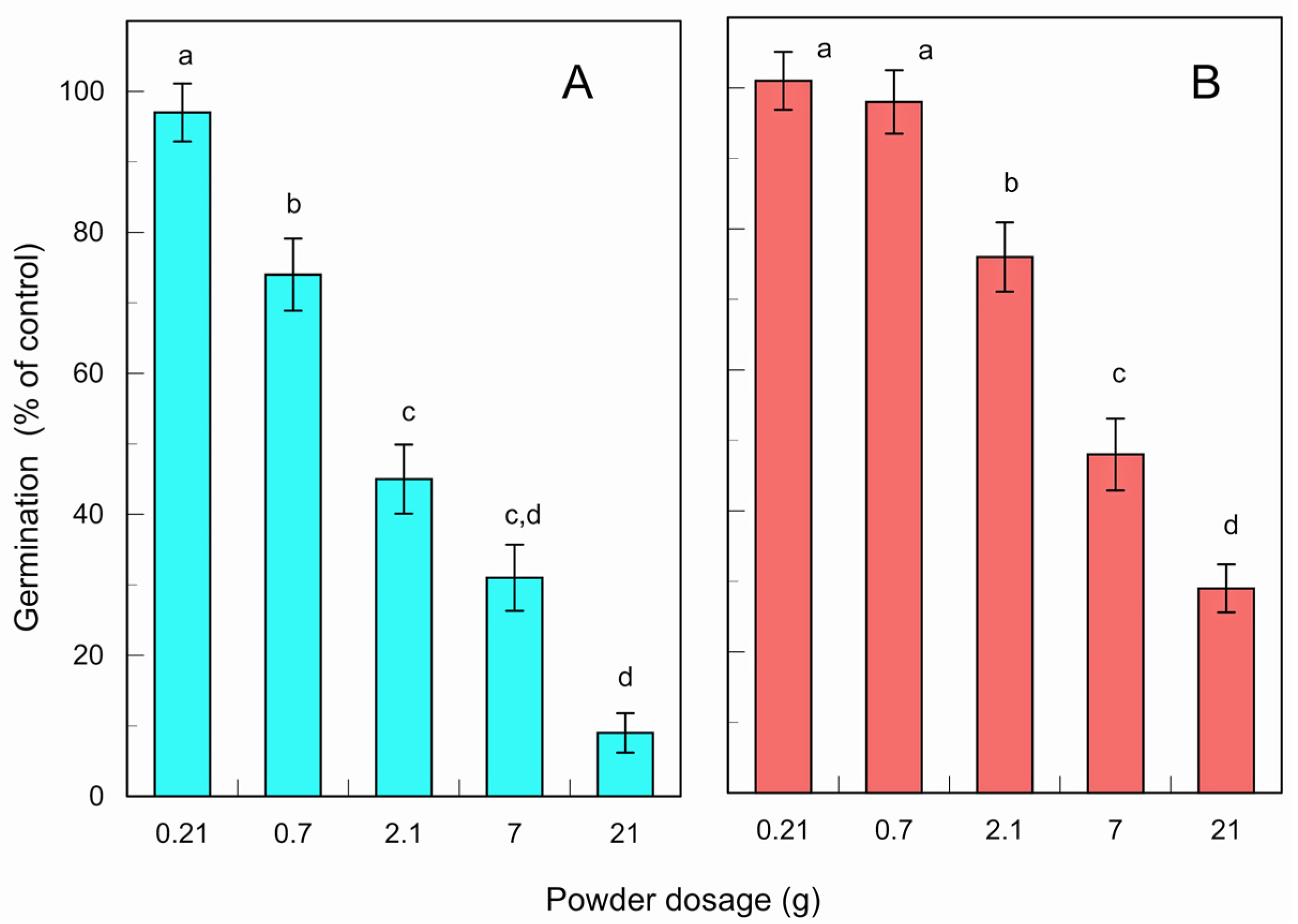
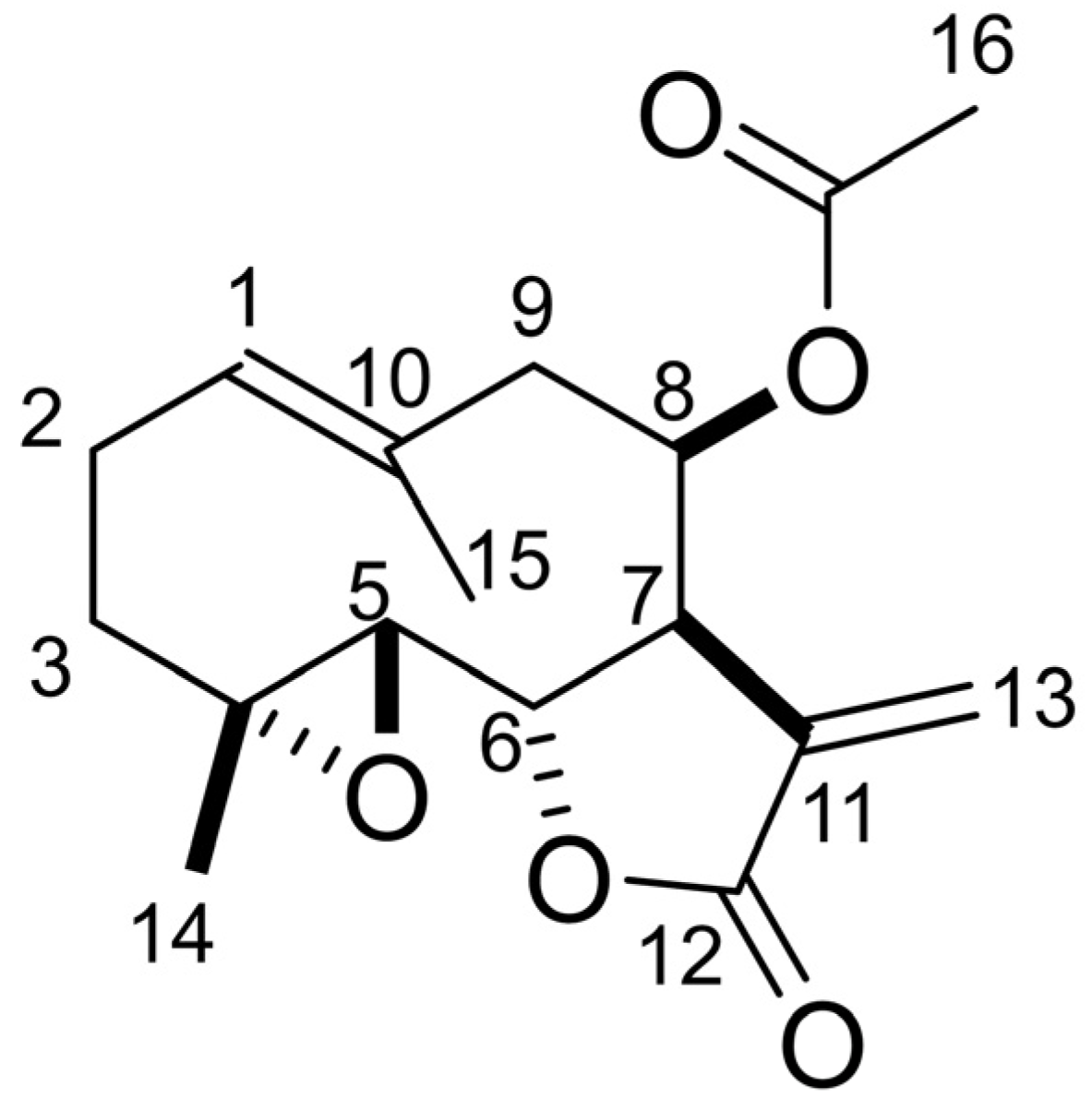
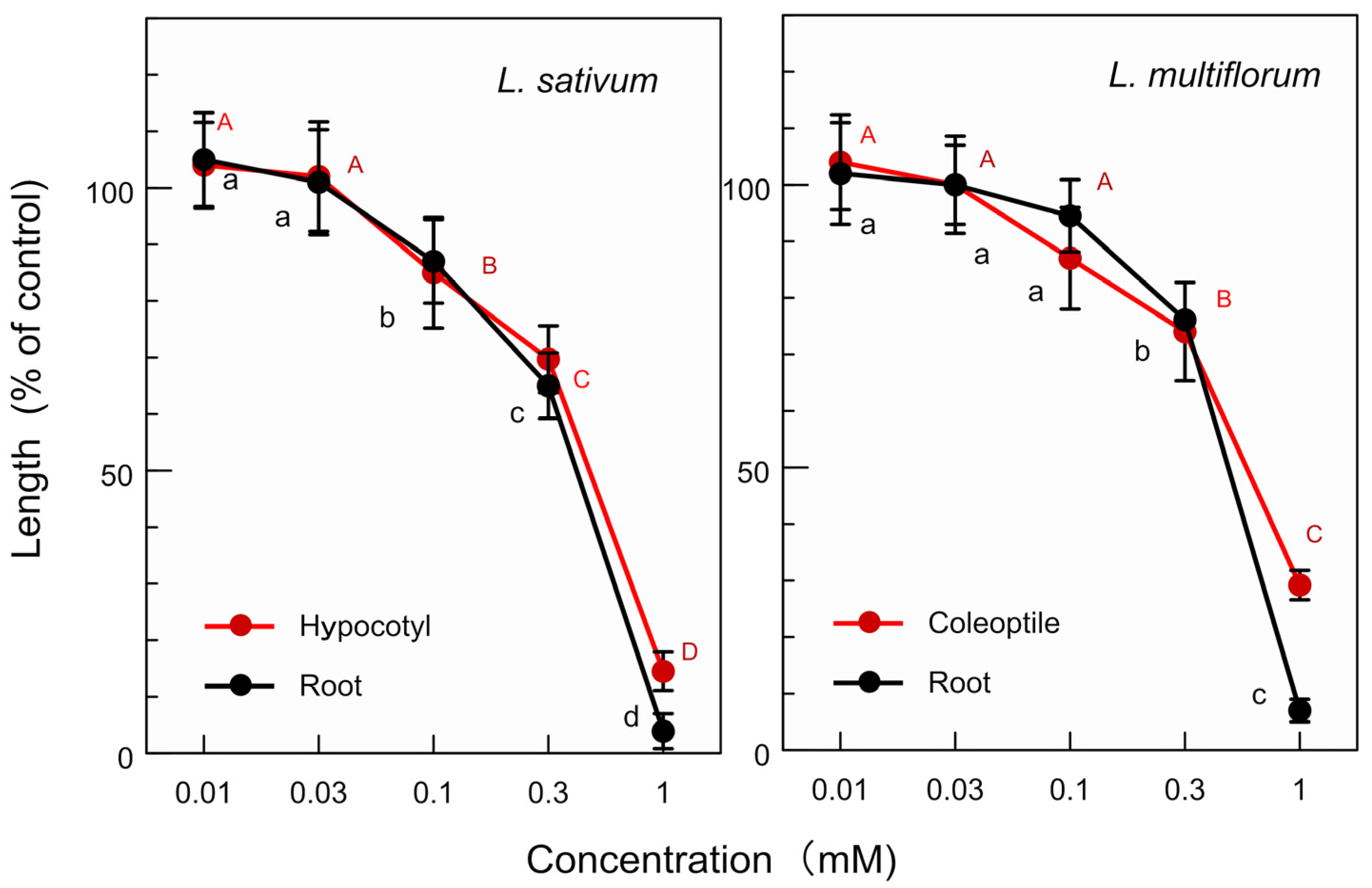
| Fresh Leaf Extract | Fallen Leaf Extract | |||
|---|---|---|---|---|
| (mg Leaf Equivalent Extract Per mL) | ||||
| Test Plant | Coleoptile | Root | Coleoptile | Root |
| V. myuros | 7.9 | 2.8 | 7.9 | 2.8 |
| E. crus-galli | 9.1 | 1.5 | 9.1 | 1.5 |
| L. multiflorum | 9.9 | 2.4 | 9.9 | 2.4 |
Disclaimer/Publisher’s Note: The statements, opinions and data contained in all publications are solely those of the individual author(s) and contributor(s) and not of MDPI and/or the editor(s). MDPI and/or the editor(s) disclaim responsibility for any injury to people or property resulting from any ideas, methods, instructions or products referred to in the content. |
© 2024 by the authors. Licensee MDPI, Basel, Switzerland. This article is an open access article distributed under the terms and conditions of the Creative Commons Attribution (CC BY) license (https://creativecommons.org/licenses/by/4.0/).
Share and Cite
Kato-Noguchi, H.; Hayashi, K.; Iwasaki, A.; Suenaga, K. Allelopathic Activity of Leaf Wastes of Liriodendron tulipifera for Sustainable Management. Appl. Sci. 2024, 14, 8437. https://doi.org/10.3390/app14188437
Kato-Noguchi H, Hayashi K, Iwasaki A, Suenaga K. Allelopathic Activity of Leaf Wastes of Liriodendron tulipifera for Sustainable Management. Applied Sciences. 2024; 14(18):8437. https://doi.org/10.3390/app14188437
Chicago/Turabian StyleKato-Noguchi, Hisashi, Kota Hayashi, Arihiro Iwasaki, and Kiyotake Suenaga. 2024. "Allelopathic Activity of Leaf Wastes of Liriodendron tulipifera for Sustainable Management" Applied Sciences 14, no. 18: 8437. https://doi.org/10.3390/app14188437
APA StyleKato-Noguchi, H., Hayashi, K., Iwasaki, A., & Suenaga, K. (2024). Allelopathic Activity of Leaf Wastes of Liriodendron tulipifera for Sustainable Management. Applied Sciences, 14(18), 8437. https://doi.org/10.3390/app14188437






